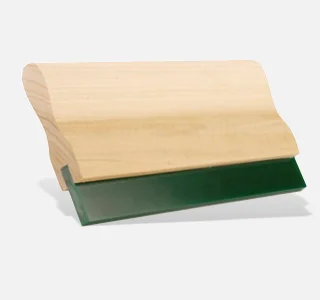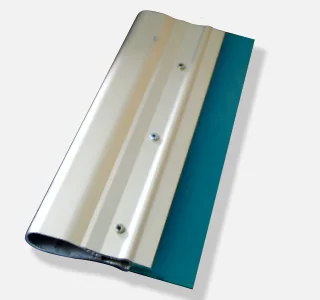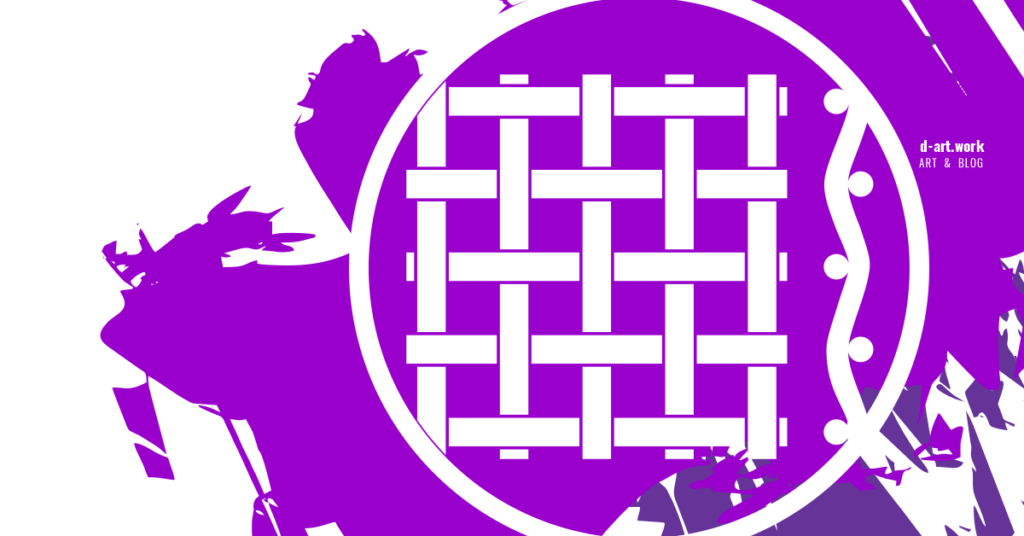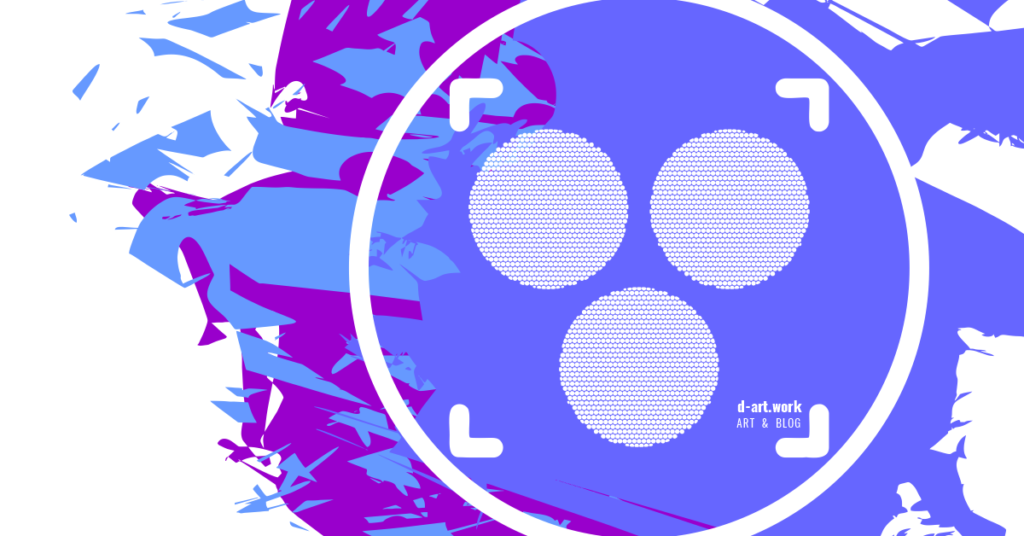The silkscreen squeegee is a tool composed of a part usually made of wood or aluminum – the handle – and a rubber part – the blade – for the purpose of distributing and pressing the ink during printing.
Unsuitable rubber types or worn or damaged rubbers will not allow even ink transfer, seriously compromising print registration and definition. This is not an expensive tool, around $25.00 (plus shipping) for a 70A 30 cm squeegee, either with a wooden handle or an aluminum handle. However, it is relatively simple to build the squeegee at home and in this case wood becomes the most viable material.


Whether buying the squeegee or making it, the factors to take into consideration are the size, type, and rubber edge cut. For this understanding, here are some technical notes on the characteristics and materials marketed today.
The rubbers used in squeegees are generally of 4 basic types of materials: natural rubber, nitrile rubber, neoprene (synthetic rubber-like polymer) and polyurethane (synthetic plastic material). Natural rubber tends to suffer from low resistance to abrasion and strong solvents, so it is generally used in the educational part of the screen printing industry. Nitrile rubber is about on par with neoprene, although somewhat less expensive and less resistant to temperature and abrasion; both more expensive than natural rubber, offer better resistance to friction and chemical aggression, suitable for short print runs, therefore quite commonly used in hand screen printing. Polyurethane is often used to make squeegees designed for extended use, applied to automatic and semi-automatic equipment.
Although more expensive than natural rubber, nitrile, and neoprene, urethane offers much better resistance to abrasion, both physical and chemical, so polyurethane squeegees are the most popular on the market for all applications.
Once the rubber has been chosen, its hardness must be determined – soft, medium or hard. The hardness of rubber is measured in units of shore and type A (soft rubbers and plastics). Typically, the substrate and the lineage of the screen directly determine the hardness to be adopted. For example, if you want to print on an uneven or rough surface, using a low and thick screen lineage (printing thick fabrics, for example), a squeegee with a blade hardness between 50A and 65A would be recommended. In the case of a smooth substrate and a very fine screen, a squeegee between 80A and 90A would be preferred.
|
However, the most popular rubber hardness, regardless of the specific industry, is 70A, as it provides the best ratio of characteristics and adaptability to most applications; stiff enough for perfect transfer of the paint through the mesh and soft enough for sliding and adaptability to the outline of the screen.
Harder rubbers are typically used in automated industrial equipment that allows fast printing. Softer rubbers are typically used in semi-automatic and manual processes.
Nitrile rubber squeegees generally have a gray or slightly pinkish color and a hardness of 65A; neoprene blade squeegees range from lighter or darker brownish tones and a hardness of 65A or 70A. Polyurethane squeegees come in a wide variety of reference and hardness options, so the manufacturers have decided to adopt a basic, though not regulated, color scale for distinguishing hardnesses. You will find codes such as PU (PolyUretain) and H (code associated with Heavy Duty) followed by numbers such as 100, 300, 500 and 700 that refer to a set of characteristics developed for durability in high temperatures, abrasion, humidity and contaminants, so in relation to polyurethane squeegees the illustration of the following table is justified:
PolyUretain Rubber (PU) Table
Silkscreen Squeegee
PU H100
Suitable for high viscosity printing, textiles, resistance to oil and most common solvents, water resistance and antistatic properties. Used in manual and semi-automatic screen printing.
PU H300
Resistance to strong solvents, corrosion resistance, friction products, applicable to high-speed printing, packaging, glass, UV printing, PCB (printed circuit board) industry, CD printing, widely used in general printing industry.
PU H500
Excellent resistance to solvents, wear, acid and alkaline corrosion, resistant to UV effects, applicable to all types of printing, but especially to PVC, aluminum polyester and polycarbonate based materials, ideal for vinyl inks.
PU H700
Total resistance to high pressures and the strongest solvents, high corrosion, wear, deformation, applicable to automated machines, long lasting product. Reduced debris in ink deposit, even at high speed.
PU HD1
Option for the most demanding serigraphers; highly resistant to abrasion, highly aggressive inks and solvents; specially produced to reduce squeegee swelling, giving it long durability.
The cut or profile of the silkscreen squeegee rubber determines the expected paint deposit thickness, as well as the squeegee effectiveness on different substrates. The most common cuts include the straight profile, rounded profile, beveled or chamfered profile on one or both sides. The straight profile is the most common and used, effective in most applications when used correctly. Round cuts are generally intended for the textile industry and are used when a thick paint deposit is required. Beveled profiles are generally used on concave surfaces or heavy materials.
Most Common Silkscreen Squeegee Edge Blades
In addition to these cuts, there are variants and differences in the bevel cut degrees, depending on the desired angle, regarding precision, inks, and equipment used. Today, double or triple hardness innovations are also mentioned on the same squeegee for industrial purposes – where screen printing is constantly pushed to its limits. Squeegees composed of layers of rubbers of different hardnesses, including even glass fiber parts, have been created not only for the sake of better print quality but also to reduce durability problems generated by the automation and long print runs associated with large industrial equipment.
Find references and more knowledge in Learning Links


Hi!
This is a very nice post, taught me a few things… But there will be continuation, right? It is not complete…
Thank you very much! And yes! There is a part II for this article, I’ll post it as soon as possible! Thank you!!!
Hola Diva, muy interesante tu sitio web. Saludos, Roberto.
¡Hola, Roberto! ¡Muchas gracias! Fantástico tu trabajo de ilustración, ¡me ha encantado!
El blog es una matriz de http://www.robertohernandez.es
Intento ser follower tuyo pero se me abre una ventana del TCF.
WOW, gran artista. Técnica y sensibilidad, muy buen dominio del color, mano talentosa.
La mayoría de los seguidores son de WordPress, me siguen a través de Reader…
De acuerdo, te sigo por el reader. También te sigo por LinkedIn a través de la editorial.
Estamos en contacto!!!!!! Muito obrigado!
Já respondi no LinkedIn! Eu é que agradeço! Vamos seguindo!